Nof S.Y. Springer Handbook of Automation
Подождите немного. Документ загружается.

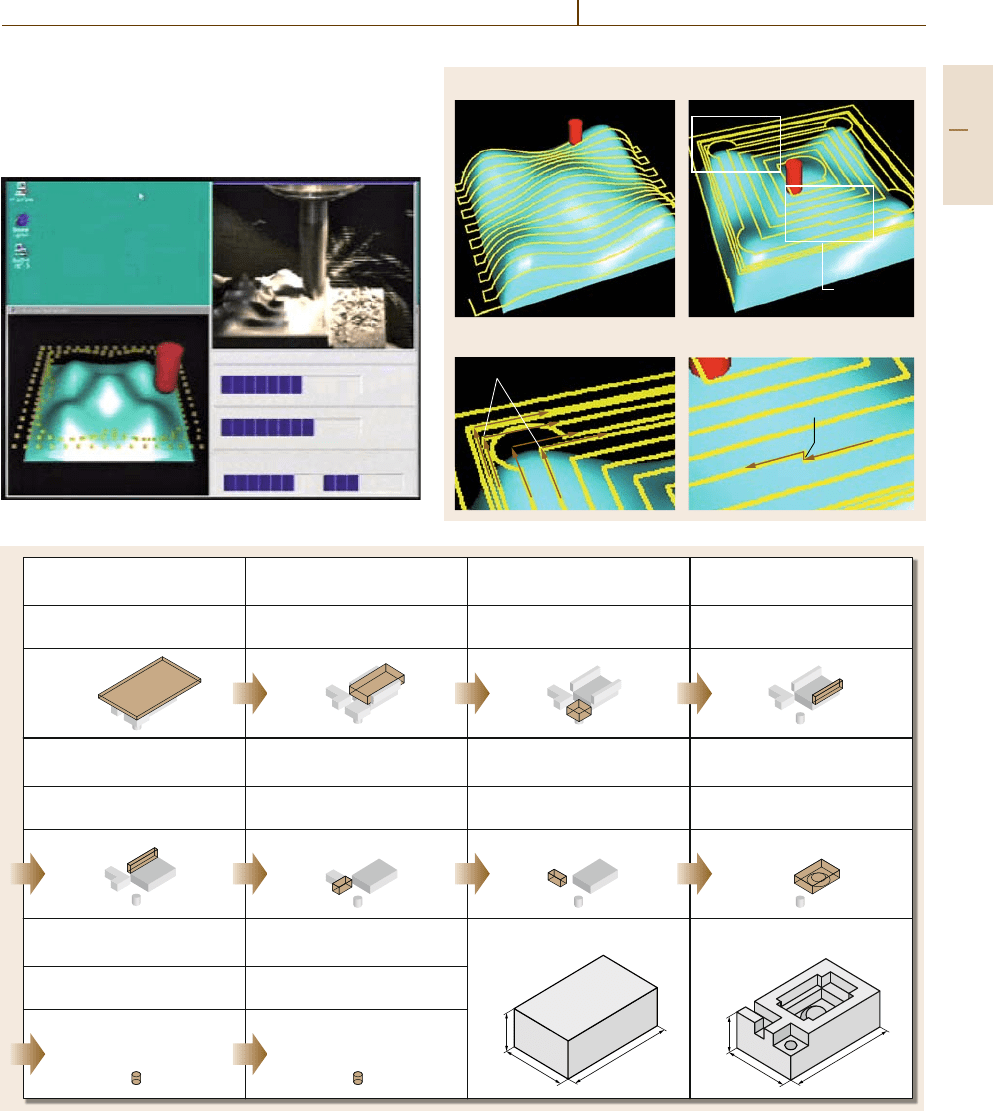
Machine Tool Automation 48.4 Technical Innovation in NC Machine Tools 855
Fig. 48.30a–d Example of real-time tool-path generation.
(a) Bilateral zigzag paths; (b) contouring paths; (c) change
of stepover;
(d) change of cutting depth
Cutting torque (Nmm)
1104
Feed rate (mm/min)
Cutting depth (mm)
RD 4 AD 2.7
650
Fig. 48.31 Adaptive milling on AIMac
S = 1680 rpm, F = 241 mm/min
RD = 4.5 mm, AD = 2.1 mm
S = 2450 rpm, F = 346 mm/min
RD = 1.6 mm, AD = 3.8 mm
S = 1000 rpm, F = 230 mm/min
RD = 8 mm, AD = 5 mm
S = 2450 rpm, F = 346 mm/min
RD = 1.6 mm, AD = 3.8 mm
S = 3539 rpm, F = 413 mm/min
RD = 1.2 mm, AD = 2.1 mm
S = 3539 rpm, F = 413 mm/min
RD = 1.2 mm, AD = 2.1 mm
S = 2450 rpm, F = 346 mm/min
RD = 1.6 mm, AD = 3.8 mm
S = 848 rpm, F = 180 mm/minS = 1154 rpm, F = 232 mm/min
S = 2580 rpm, F = 335 mm/min
RD = 1.3 mm, AD = 3.2 mm
33
60
100
38
60
100
End mill Ø16 mm
Scanning-line mode
End mill Ø10 mm
Contour-line mode
Face mill Ø80 mm
Scanning-line mode
Raw material shape Finished shape
Face
1
End mill Ø10 mm
Scanning-line mode
Closed pocket
2
Open pocket
3
Closed slot
4
End mill Ø6 mm
Scanning-line mode
End mill Ø6 mm
Scanning-line mode
End mill Ø10 mm
Scanning-line mode
Closed slot
5
Ball end mill Ø10 mm
Scanning-line mode
Closed slot
6
Drill Ø10 mm
Drilling mode
Center drill Ø3 mm
Drilling mode
Blind hole
9
Blind hole
10
Open slot
7
Free form
8
Fig. 48.32 Results of machining process planning on AIMac
Change of cutting depth
Change of
cutting depth
Change of stepover
Change of stepover
a) b)
c) d)
Part F 48.4
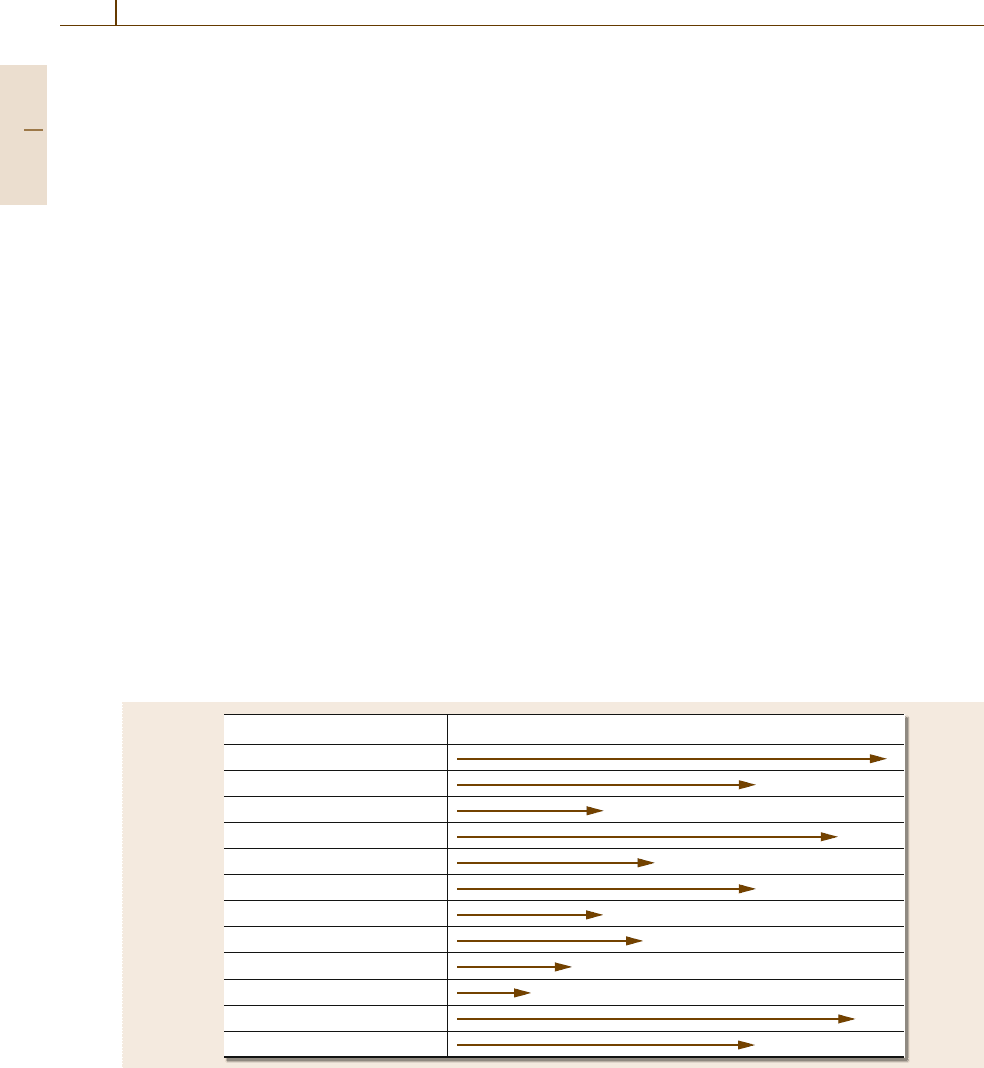
856 Part F Industrial Automation
Flexible Process
and Operation Planning System
A flexible process and operation planning system has
been developed to generate cutting parameters dynami-
cally for machining operation. The system can generate
the production plan from the total removal volume
(TRV). The TRV is extracted from the initial and
finished shapes of the product and is divided into ma-
chining primitives or machining features. The flexible
process and operation planning system can generate
cutting parameters according to the machining features
detected. Figure 48.32 shows the operation sequence
and cutting tools to be used. Cutting parameters are
determined for the experimental machining shape. The
digital copy milling system can generate the tool paths
or CL data dynamically according to these results and
perform the autonomous milling operation without re-
quiring any NC program.
48.5 Key Technologies for Future Intelligent Machine Tool
Several architectures and technologies have been pro-
posed and investigated as mentioned in the previous
sections. However, they are not yet mature enough to
be widely applied in practice, and the achievements of
these technologies are limited to specific cases.
Achievements of key technologies for future in-
telligent machine tools are summarized in Fig.48.33.
Process and machining quality control will become
more important than adaptive control. Dynamic tool-
path generation and in-process cutting parameters
modification are required to realize flexible machining
operation for process and machining quality control.
Additionally, intelligent process monitoring is needed
to evaluate the cutting process and machining quality
Motion control
Adaptive control
Process and quality control
Monitoring (sensing)
Intelligent process monitoring
Open architecture concept
Process planning
Operation planning
Utilization of knowhow
Learning of knowhow
Network communication
Distributed computing
Key technologies Conceptual >>>>> >>>>>Confirmed Practical
Fig. 48.33 Achievements of key technologies for future intelligent machine tools
for process and machining quality control.A reasonable
strategy to control the cutting process and a reasonable
index to evaluate machining quality are required. It is
therefore necessary to consider utilization and learning
of knowledge, knowhow, and skill regarding machining
operations.
A process planning strategy with which one can
generate flexible and adaptive working plans is re-
quired. An operation planning strategy is also required
to determine the cutting tool and parameters. Prod-
uct data analysis and machining feature recognition are
important issues in order to generate operation plans
autonomously.
Sections 48.4.2–48.5 are quoted from [48.14].
Part F 48.5

Machine Tool Automation References 857
48.6 Further Reading
•
Y. Altintas: Manufacturing Automation: Metal Cut-
ting Mechanics, Machine Tool Vibrations, and CNC
Design (Cambridge Univ. Press, Cambridge 2000)
•
J.G. Bollinger, N.A. Duffie: Computer Control of
Machines and Processes (Addison-Wesley, Boston
1988)
•
E.P. DeGarmo, J.T. Black, R.A. Kosher: DeGarmo’s
Materials and Processes in Manufacturing (Wiley,
New York 2007)
•
K. Evans: Programming of CNC Machines (Indus-
trial, New York 2007)
•
Y. I t o : Modular Design for Machine Tools
(McGraw-Hill, New York 2008)
•
K.-H. John, M. Tiegelkamp: IEC 61131-3: Pro-
gramming Industrial Automation Systems (Springer,
Berlin Heidelberg 2001)
•
S. Krar, A. Gill, P. Smid, P. Wanner: Machine
Tool Technology Basics (Industrial, New York
2003)
•
I.D. Marinescu, C. Ispas, D. Boboc: Handbook
of Machine Tool Analysis (CRC, Boca Raton
2002)
•
B.W. Niebel, A.B. Draper, R.A. Wysk: Modern
Manufacturing Process Engineering,(McGraw-
Hill, London 1989)
•
G.E. Thyer: Computer Numerical Control of
Machine Tools, (Butterworth-Heinemann, London
1991)
•
K.-H. Wionzek: Numerically Controlled Machine
Tools asa SpecialCase ofAutomation(Didaktischer
Dienst, Berlin 1982)
References
48.1 Y. Koren: Control of machine tools, ASME J. Manuf.
Sci. Eng. 119, 749–755 (1997)
48.2 G. Pritschow, Y. Altintas, F. Jovane, Y. Koren,
M. Mitsuishi, S. Takata, H. Brussel, M. Weck,
K. Yamazaki: Open controller architecture – past,
present and future, Ann. CIRP 50(2), 463–470 (2001)
48.3 Y. Altintas, N.A. Erol: Open architecture modular
tool kit for motion and machining process control,
Ann. CIRP 47(1), 295–300 (1998)
48.4 M. Mori, K. Yamazaki, M. Fujishima, J. Liu, N. Fu-
rukawa: A study on development of an open servo
system for intelligent control of a CNC machine tool,
Ann. CIRP 50(1), 247–250 (2001)
48.5 K.Yamazaki,Y.Hanaki,Y.Mori,K.Tezuka:Au-
tonomously proficient CNC controller for high
performance machine tool based on an open ar-
chitecture concept, Ann. CIRP 46(1), 275–278 (1997)
48.6 H.Ng,J.Liu,K.Yamazaki,K.Nakanishi,K.Tezuka,
S. Lee: Autonomous coordinate measurement
planning with work-in-process measurement for
TRUE-CNC, Ann. CIRP 47(1), 455–458 (1998)
48.7 X. Yan, K. Yamazaki, J. Liu: Extraction of milling
know-how from NC programs through reverse en-
gineering, Int. J. Prod. Res. 38(11), 2443–2457 (2000)
48.8 M. Mitsuishi, T. Nagao, H. Okabe, M. Hashiguchi,
K. Tanaka: An open architecture CNC CAD-CAM ma-
chining system with data-base sharing and mutual
information feedback, Ann. CIRP 46(1), 269–274
(1997)
48.9 M. Mitsuishi, T. Nagao: Networked manufacturing
with reality sensation for technology transfer, Ann.
CIRP 48(1), 409–412 (1999)
48.10 K. Morishige, Y. Takeuchi, K. Kase: Tool path gener-
ation using C-space for 5-axis control machining,
ASME J. Manuf. Sci. Eng. 121, 144–149 (1999)
48.11 K. Morishige, Y. Takeuchi: Strategic tool atti-
tude determination for five-axis control machining
basedonconfigurationspace,CIRPJ.Manuf.Syst.
31(3), 247–252 (2003)
48.12 K. Shirase, T. Kondo, M. Okamoto, H. Wakamatsu,
E. Arai: Trial of NC programless milling for a basic
autonomous CNC machine tool, Proc. 2000 JAPAN-
USA Symp. Flex. Autom. (JUSFA2000) (2000) pp. 507–
513
48.13 K. Shirase, K. Nakamoto, E. Arai, T. Moriwaki: Dig-
ital copy milling – autonomous milling process
control without an NC program, Robot. Comput.
Integr. Manuf. 21(4-5), 312–317 (2005)
48.14 T. Moriwaki, K. Shirase: Intelligent machine
tools: current status and evolutional architecture,
Int. J. Manuf. Technol. Manag. 9(3/4), 204–218
(2006)
Part F 48
“This page left intentionally blank.”

859
Digital Manuf
49. Digital Manufacturing
and RFID-Based Automation
Wing B. Lee, Benny C.F. Cheung, Siu K. Kwok
Advances in the Internet, communication tech-
nologies, and computation power have accelerated
the cycle of new product development as well
as supply chain efficiency in an unprecedented
manner. Digital technology provides not only an
important means for the optimization of produc-
tion efficiency through simulations prior to the
start of actual operations but also facilitates man-
ufacturing process automation through efficient
and effective automatic tracking of production
data from the flow of materials, finished goods,
and people, to the movement of equipment and
assets in the value chain. There are two major
applications of digital technology in manufactur-
ing. The first deals with the modeling, simulation,
and visualization of manufacturing systems and
the second deals with the automatic acquisition,
retrieval, and processing of manufacturing data
used in the supply chain. This chapter summarizes
the state of the art of digital manufacturing which
is based on virtual manufacturing (VM) simulation
and radio frequency identification (RFID)-based
automation. The associated technologies, their key
techniques, and current research work are high-
lighted. In addition, the social and technological
obstacles to the development of a VM system and
in an RFID-based manufacturing process automa-
tion system, and some practical application case
studies of digital manufacturing based on VM and
RFID-based automation, are also discussed.
49.1 Overview.............................................. 859
49.2 Digital Manufacturing
Based on Virtual Manufacturing (VM)...... 860
49.2.1 Concept of VM............................ 860
49.2.2 Key Technologies Involved in VM .. 861
49.2.3 Some Typical Applications of VM... 862
49.2.4 Benefits Derived from VM ............ 863
49.3 Digital Manufacturing
by RFID-Based Automation.................... 864
49.3.1 Key RFID Technologies................. 865
49.3.2 Applications
of RFID-Based Automation
in Digital Manufacturing ............. 867
49.4 Case Studies of Digital Manufacturing
andRFID-BasedAutomation.................. 867
49.4.1 Design of Assembly Line
and Processes for Motor Assembly 867
49.4.2 A VM System for the Design
and the Manufacture
of Precision Optical Products........ 868
49.4.3 Physical Asset Management (PAM) 869
49.4.4 Warehouse Management............. 872
49.4.5 Information Interchange
in Global Production Networks..... 874
49.4.6 WIP Tracking.............................. 876
49.5 Conclusions.......................................... 877
References .................................................. 878
49.1 Overview
The industrial world is undergoing profound changes
as the information age unfolds [49.1]. The competi-
tive advantage in manufacturing has shifted from the
mass-production paradigm to one that is based on fast
responsiveness and on flexibility [49.2]. One of the
important issues in manufacturing is related to the in-
tegration of engineering and production activities. This
includes integration of developers, suppliers, and cus-
Part F 49
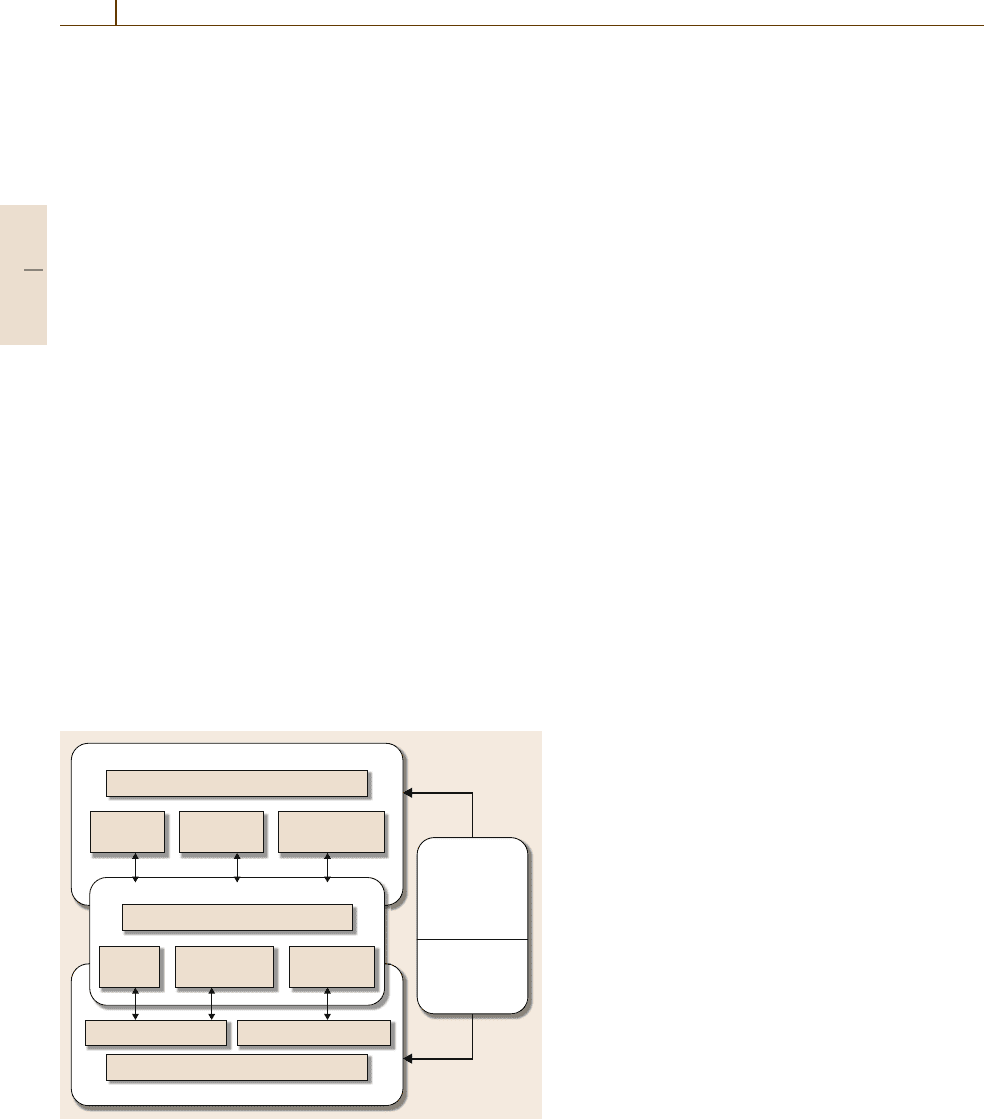
860 Part F Industrial Automation
tomers through the entire production cycle, involving
design, production, testing, servicing, and marketing.
The scope of digital manufacturing includes manifest-
ing physical parts directly from three dimensional (3-D)
computer-aided design (CAD) files or data, using addi-
tive fabrication techniques such as 3-D printing, rapid
prototyping from virtual manufacturing (VM) models,
and the use of radiofrequency identification (RFID)
for supporting manufacturing process optimization and
resources planning. Examples can be found in Red-
Eye [49.3], Stratasys [49.4], and Autodesk [49.5]. To
achieve the integration, digital manufacturing, which
covers all the engineering functions, information flow,
and the precise characteristics of a manufacturing sys-
tem are needed. Manufacturing enterprises are now
forced to digitize manufacturing information and accel-
erate their manufacturinginnovation in order to improve
their competitive edge in the global market.
There are two major applications of digital tech-
nology in manufacturing. One is based on virtual
manufacturing, which deals with the modeling, simu-
lation, and visualization of manufacturing systems. The
second is based on the automation of the manufactur-
ing process and deals with the automatic acquisition,
retrieval, and processing of manufacturing data en-
countered in the supply chain. In this chapter, the state
of the art of digital manufacturing based on recent
advances in VM and RFID-based automation is sum-
marized. The concept and benefits of VM and RFID
are presented, while the associated technologies, their
key techniques, and current research work are also
highlighted. The social and technological obstacles in
the development of a VM system and an RFID-based
manufacturing process automation system together with
some case studies are discussed at the end of the
chapter.
49.2 Digital Manufacturing Based on Virtual Manufacturing (VM)
49.2.1 Concept of VM
Digital manufacturing based on VM integrates man-
ufacturing activities dealing with models and sim-
ulations, instead of objects and their operations in
the real world. This provides a digital tool for the
Comparison
and model
maintenance
Virtual
prototyping
Product
model
Manufacturing
resource model
Manufacturing environment model
Manufacturing environment
Prototype and product Manufacturing resources
Monitoring
Virtual world
Real world
Manufacturing
preparation
Product
design
Production
management
Task organization
Engineering activity
Fig. 49.1 Conceptual view of a virtual manufacturing system (after
Kimura et al. [49.6])
optimization of the efficiency and effectiveness of
the manufacturing process through simulations prior
to actual operation and production. A VM system
can produce digital information to facilitate physical
manufacturing processes. The concept, significance,
and related key techniques of VM were addressed
by Lawrence Associate Inc. [49.7] while the contri-
bution and achievements of VM were reviewed by
Shukla [49.8]. As mentioned by Kimura [49.6], a typ-
ical VM system consists of a manufacturing resource
model, a manufacturing environment model, a prod-
uct model, and a virtual prototyping model. Some
active research work is found in the study of both
conceptual and constructive VM systems. Onosato and
Iwata [49.9] developed the concept of a VM system,
and Kimura [49.6] described the product and process
model of a VM system. Based on the concept and the
model, Iwata et al. [49.10] proposed a general modeling
and simulation architecture for a VM system. Gause-
meier et al. [49.11] has developed a cyberbike VM
system for the real-time simulation of an enterprise that
produces bicycles. With the use of a VM system, people
can observe the information in terms of the structure,
states, and behaviors equivalent to a real manufactur-
ing environment, in a virtual environment [49.12, 13].
Various manufacturing processes can be integrated and
realized in one system so that manufacturing cost and
Part F 49.2

Digital Manufacturing and RFID-Based Automation 49.2 Digital Manufacturing Based on Virtual Manufacturing (VM) 861
time to market can be reduced and productivity can be
significantly improved.
A conceptual view of a VM system according to
Kimura [49.6] is shown in Fig.49.1. The manufactur-
ing activities and processes are modeled before, and
sometimes in parallel with, the operations in the real
world. Interaction between the virtual and real worlds is
accomplished by continuous monitoring of the perfor-
mance of the VM system. Since a VM model is based
on real manufacturing facilities and processes, it pro-
vides realistic information about the product and its
manufacturing processes, and also allows for their eval-
uation and validation. Since no physical conversion of
materials into products is involved in VM, this helps
to enhance production flexibility and reduce the cost of
production as the cost for making the physical proto-
types can be reduced.
Basically, the classification of a VM system is based
on the type of system integration, the product and
process design, and the functional applications. Ac-
cording to the definitions proposed by Onosato and
Iwata [49.9], every manufacturing system can be de-
composed into four different subsystems: a real and
physical system(RPS), a real information system (RIS),
a virtual physical system (VPS), and a virtual infor-
mation system (VIS). A RPS consists of substantial
entities such as materials, parts, and machines that ex-
ist in the real world, while a RIS involves the activities
of information processing and decision making such as
design, scheduling, controlling, and prediction, etc. On
the other hand, a computer system that simulates the re-
sponses of a real physical system is a virtual physical
system, which can be represented by a factory model,
product model, and a production process model. The
production process models are used to determine the in-
teractions between the factory model and each of the
product models. A VIS isa computersystem which sim-
ulates a RIS and generates control commands for the
RPS.
VM can be subdivided into product-design-centered
VM, production-centered VM, and control-centered
VM according to the product design and process de-
sign functions. The product-design-centered VM makes
use of different virtual designs to produce the produc-
tion prototype. The relevant information about a new
product (product features, tooling, manufacturability,
etc.) is provided to the designer and to the manufac-
turing system designers to support decision making in
the product design process. Production-centered VM
is based on the RPS or VPS to simulate the activities
in process development and alternative process plans
while the control-centered VM aims at optimizing the
production cycles based on dynamic control of process
parameters.
Production-centered VM, on the other hand, is
based on the functional use so as to provide interactive
simulation of various manufacturing or business pro-
cesses such as virtual prototyping, virtual operational
system, virtual inspection, virtual machining, virtual as-
sembly, etc. Virtual prototyping (VP) mainly deals with
the processes, tooling, and equipment such as injec-
tion molding processes, while virtual machining mainly
deals with cutting processes such as turning, milling,
drilling and grinding, etc. Finally, control-centered VM
technology is used to study the factors affecting the
quality, machining time, and costs based on the mod-
eling and simulation of the material removal process as
well as on the relative motion between the tool and the
workpiece. Virtual inspection makes use of VM tech-
nology to model and simulate the inspection process,
and the physical and mechanical properties of the in-
spection equipment. The aim of this is to study the
inspection methodologies,inspection plans,and the fac-
tors affecting the accuracy ofthe inspection process,etc.
In assembly work, VM is mainly used to investigate
the assembly processes, the mechanical and physical
characteristics of the equipment and tooling, and the in-
terrelationship between different parts so as to predict
the quality of an assembly or product cycle. It will also
examine the costs as well as evaluating the feasibility
of the plan of the assembly process. VM can also be
used for virtual operational control, the aim of which is
to evaluate the design and operational performance of
the material flow and information flow system, etc. VM
technology is also used for investigating the human be-
havior of the different workers who handle the various
tasks such as assembling parts, queuing, handling doc-
uments, etc. The human factors affecting the operation
of a manufacturing or business system can be predicted
and evaluated.
49.2.2 Key Technologies Involved in VM
The development of VM demands multidisciplinary
knowledge and technologies related to computer hard-
ware and software, information technology, microelec-
tronics, manufacturing, and mathematical computation.
The key technological areas related to VM are:
1. Visualization technologies
VM makes useof directgraphic interfaces todisplay
highly accurate, easily understandable, and accept-
Part F 49.2
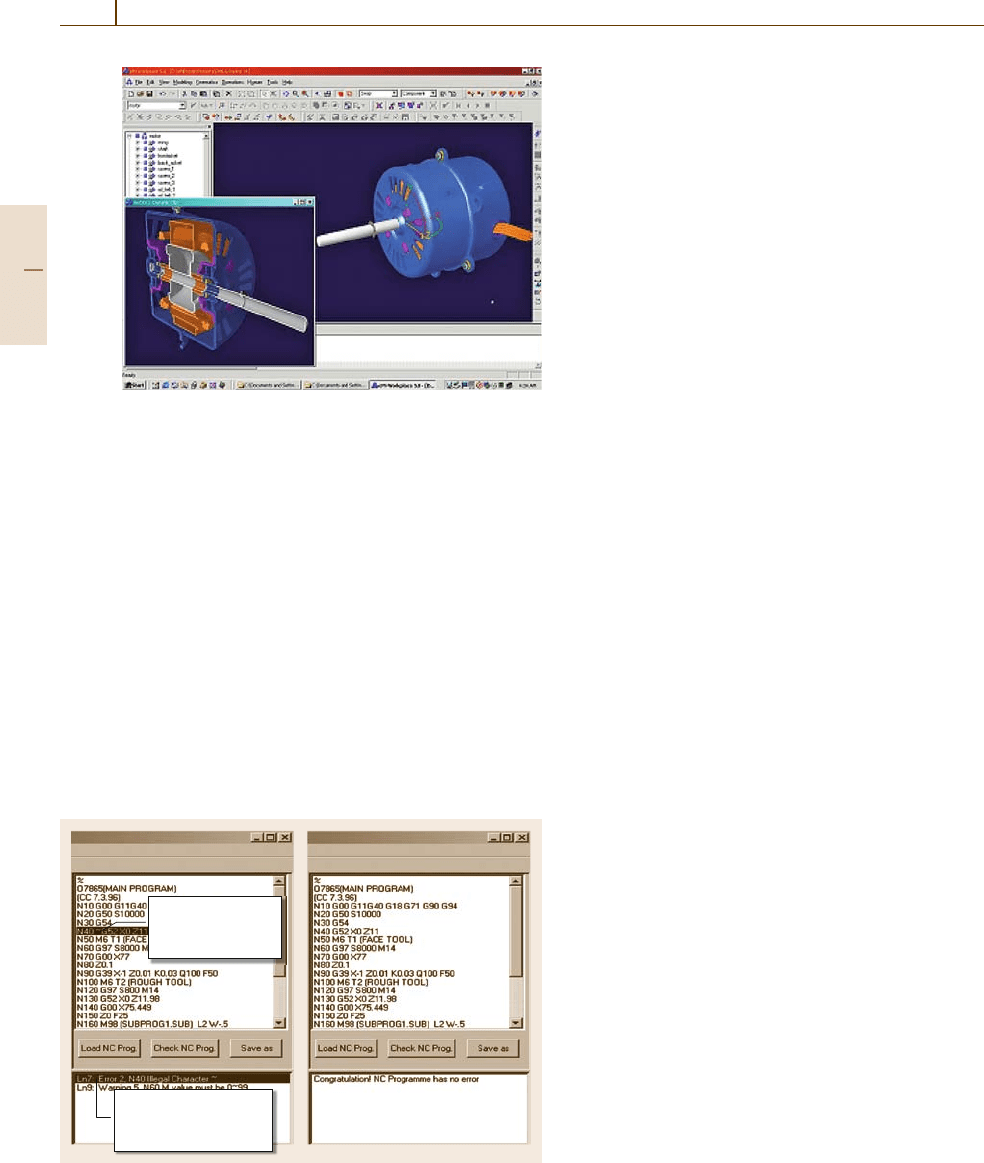
862 Part F Industrial Automation
Fig. 49.2 Evaluation of product design
able input and output information for the user. This
demands advanced visualization technologies such
as image processing, virtual reality (VR), multime-
dia, design of graphic interfaces, animation, etc.
2. Techniques for the establishment of a virtual manu-
facturing environment
A computerized environment for VM operations is
vital. This includes the hardware and software for
the computer, modeling and simulation of the in-
formation flow, support of the interface between the
real and the virtual environment, etc. This needs the
research and development of devices for VM oper-
ational environment, interface and control between
the VM system and the real manufacturing (RM)
system, information and knowledge integration and
acquisition, etc.
The selected block
with accident error
is highlight
a) b)
Identify the errors and
give suggestions for
correcting them
Fig. 49.3a,b NC program validation
3. Information-integrated infrastructure
This refers to the hardware and software develop-
ment for supporting the models and the sharing
of resources, i.e., information and communication
technologies (ICT) among dispersed enterprises.
4. Methods of information presentation
The information about product design and man-
ufacturing processes and related solid objects are
represented using different data formats, languages,
and data structureso asto achievethe data sharingin
the information system. There is a need for research
into advanced technologiesfor 3-D geometrical rep-
resentation, knowledge-based system description,
rule-based system description, customer-orientated
expert systems, feature-based modeling, physical
process description, etc.
5. Model formulation and reengineering techniques
In order to define, develop, and establish meth-
ods and techniques which are capable of realizing
the functions and interrelationships among various
models in the VM system, various techniques are
employed, including model exchange, model man-
agement, model structure, data exchange, etc.
6. Modeling and simulation techniques
These refer to processes and methods used to mimic
the real world, on the computer. Further research
on the technologies related to dispersed network
modeling, continuous system modeling, model
databases and their management optimization anal-
ysis, validation of simulation results, development
of simulation tools, and software packaging tech-
nique are much needed.
7. Verification and evaluation
To ensure that the output from the VM system is
equivalent to that from the RM system, related tech-
nologies such as standards of evaluation, decision
tools, and evaluation methods are needed. These
methods are useful for verifying and evaluating the
performance and reliability of different models in
VM systems and their outputs.
Some of these technologies are comparatively ma-
ture. However, most of them have to be further
developed before they can be used to form an integrated
VM platform.
49.2.3 Some Typical Applications of VM
1. VM can be used in the evaluation of the feasibil-
ity of a product design, validation of a production
and business plan, and optimization of the product
Part F 49.2
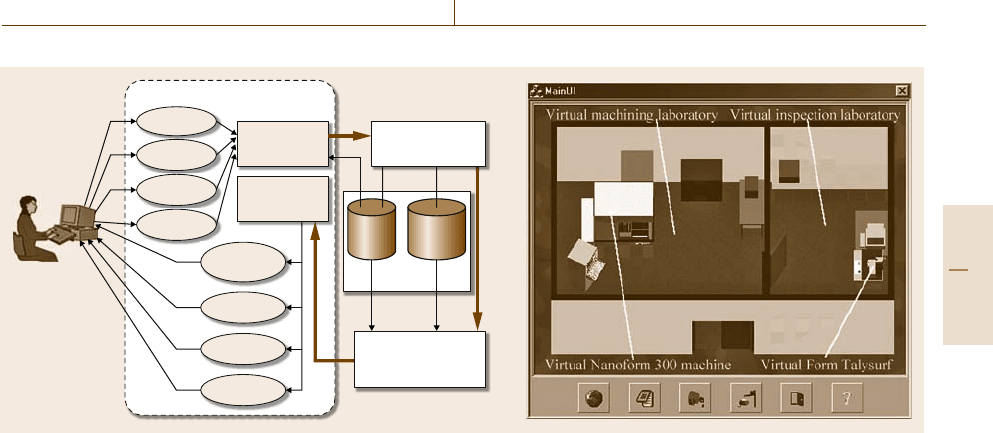
Digital Manufacturing and RFID-Based Automation 49.2 Digital Manufacturing Based on Virtual Manufacturing (VM) 863
Interactive user interface
NC program
Control
command
Tooling
information
Workpiece
information
Stereo sound
3-D graphics
Animation
Errors/warning
messages
Data
buffer
Internal
database
Information
module
Control panel
(control screen)
Virtual objects
(e.g. virtual machine and
inspection equipment)
Virtual
environment
simulator
Trainee
a) b)
Event processing
module
Fig. 49.4a,b Virtual training workshop (VTW) for ultraprecision machining center
design and of the business processes. Fine-tuning
of these will result in reduction of the cost of the
product throughout its lifecycle.
2. As shown in Figs. 49.2 and 49.3, VM can be used
to test and validate the accuracy of the product
and business process designs, for example, the de-
sign of the appearance of a product, analysis of
its dynamic characteristics, checking for the tool
path during machining process, numerical control
(NC) program validation, checking for possible
collision problems in machining [49.14] and assem-
bly [49.15].
3. Withthe useof VM, itis possible toconduct training
(Fig.49.4) in a distributed virtual environment for
the operators, technicians, and management people
on the use of manufacturing facilities. The costs of
training and production can thus be reduced.
4. As a knowledge-acquisition vehicle, VM can be
used to acquire continuously the manufacturing
or business knowhow, traditional manufacturing or
business processes, production data, etc.
49.2.4 Benefits Derived from VM
1. VM can be used not only to predict the costs of
product or process development but can also be
used to provide the information about the process
capability [49.16]. It allows for the modeling and
simulation of the activities involved in process de-
velopment and also for alternative process plans.
It also enables the rapid evaluation of a produc-
tion plan, the evaluation of the operational status
of a manufacturing system as well as of the objec-
tives of the designof the physical system such as the
degree of optimization of manufacturing resources
and facilities, etc. The information generated from
VM system is useful for improving the accuracy of
the decisions made by the designer and the man-
agement. Possible problems in product or process
development can be predicted and resolved prior to
the actual operation.
2. VM can support VP, which simulates the materials,
processes, tooling, and equipment in the fabrica-
tion of prototypes. The factors affecting the process,
product quality, and hence the material properties,
processing time, and manufacturing costs can be
analyzed with the use of modeling and simula-
tion techniques. As more computer-based product
models are developed and prototyped upstream in
the product development process using VM,the
number of downstream physical prototypes tradi-
tionally made to validate the product models and
new designs can be reduced. Hence, the product
development time can be shortened.
3. With the virtual environment provided by VM
[49.17], customers can take part in the product de-
velopment process. Design engineers can respond
more quickly to customer queries and hence pro-
vide better solutions to the customers. Discussion,
manipulation, and modification of the product data
model directly among personnel with different tech-
nical backgrounds arealso facilitated. As a result the
competitive edge of an enterprise in the market can
be enhanced.
Part F 49.2

864 Part F Industrial Automation
49.3 Digital Manufacturing by RFID-Based Automation
Another major application of digital manufacturing
deals with the automatic acquisition and processing of
manufacturing data in the supply chain. This is due
to the fact that the keen competition in global manu-
facturing has rekindled interest in lean manufacturing,
reducing inventory, and efficiency in production con-
trol. There has been growing interest worldwide in the
use of RFID to digitalize the manufacturing information
so as to automate the manufacturing process. As techni-
cal problems are slowly being overcome and the cost of
using RFID is decreasing, RFID is becoming popular in
manufacturing industries. According to industrial statis-
tics, the worldwide market for RFID technology was
US$1.49billion in 2004. In the first 6 months of 2008,
6.8billion tags were sold for these applications as well
as 15.3billion tags for pallets and cases. There is great
market demand, which is ever increasing, for various
RFID applications. It is predicted that RFID industry
figures will increase from US$ 1.95 billion in 2005 to
US$26.9billion in 2015 [49.18].
The rapid increase in use of RFID technology in the
retail industry has been driven by major players such as
Gillette, Tesco, Wal-Mart, and Metro AG in Germany.
Wal-Mart, the world’s largest retailer, has started
deploying RFID applications and implementing new
procedures in some ofits distribution centers and stores.
By January 1st, 2005, Wal-Mart required its top 100
suppliers to put RFID tags on shipping crates and pal-
lets, and by January 1st, 2006, this was expanded to
its next 200 largest suppliers. The aim of the applica-
tions is to reduce out-of-stock occurrences by providing
visibility of the location of goods by using RFID tags.
Out-of-stock items that are RFID-tagged have been
found to be replenished three times faster than before,
and the amount of out-of-stock items that have to be
manually filled has been cut by 10%.
Gillette and Tesco implemented an item-level RFID
project in the UK. Gillette razor blade cartridges were
tagged with RFID tags and Tesco, the retailer, used an
RFID reader embedded smart shelf system to search for
items in the field, in order to take on-shelf inventories.
Metro AG has implemented an item-level RFID trial
for use in its future stores. RFID tags are attached to
each pack of Gillette razor blades, Proctor and Gamble
(P&G) shampoos, Kraft cream cheese, and digital ver-
satile disks (DVDs). In addition to enhancing stock re-
plenishment operations, consumers also benefit. Shop-
ping trolleys which automatically update shopping lists
and self-check-out systems have also been implemented
using this technology. This demonstrates how RFID can
revamp the retail industry and provide new customer
experiences. With better tag and reader technology, de-
clines in the cost of RFID tagging, and the release of
information-sharing platforms, it is likely that RFID
will be widely adopted across the entire supply chain.
In recent years, the use of RFID has enabled real-
time visibility and increased the processing efficiency
of shop-floor manufacturing data. RFID also supports
information flow in process-linked applications. More-
over, it can help to minimize the need for reworking,
improve efficiency, reduce line stoppages, and replenish
just-in-time materials on the production line. RFID can
assist in automating assembly-line processes and thus
reduce labor and cost, and minimize errors on the plant
floor. The integration of RFID with various manufac-
turing systems is still a challenge to many corporations.
As most large retailers will gradually demand the use
of RFID in the goods from their suppliers, this cre-
ates both pressure and the opportunity for small and
medium sized enterprises (SMEs) to adopt this tech-
nology in their logistics operations and extend it to the
control of their manufacturing processes. Some previ-
ous work [49.19] has discussed the point that RFID
can be more cost effective in bridging the gap between
automation and information flow by providing better
traceability and reliability on the shop floor.
Traditional shop-floor control in a production envi-
ronment, although computerized, still requires manual
input of shop-floor data to various systems such as
the enterprise resources planning (ERP) for production
planning and scheduling. Such data includes product
characteristics, labor, machinery, equipment utilization,
and inspection records. Companies such as Lockheed
Martin, Raytheon, Boeing [49.20], and Bell Helicopter
have installed lean data-capture software and technolo-
gies and are in the process of converting barcodes to
RFID. Honeywell was using barcodes to collect data
related to part histories, inventories, and billing, and
sharing data with its clients, and is accelerating its plan
to switch from barcodes to RFID. The use of RFID has
several advantages over barcodes, as tags that contain
microchips that can store as well as transmit dynamic
data have a fast response, do not require line of sight,
and possess high security. RFID offers greater scope
for the automation of data capture for manufacturing
process control. In recent years, the cost of RFID tags
has continuously decreased [49.21,22] while their data
capability hasincreased, whichmakes practicalapplica-
Part F 49.3
